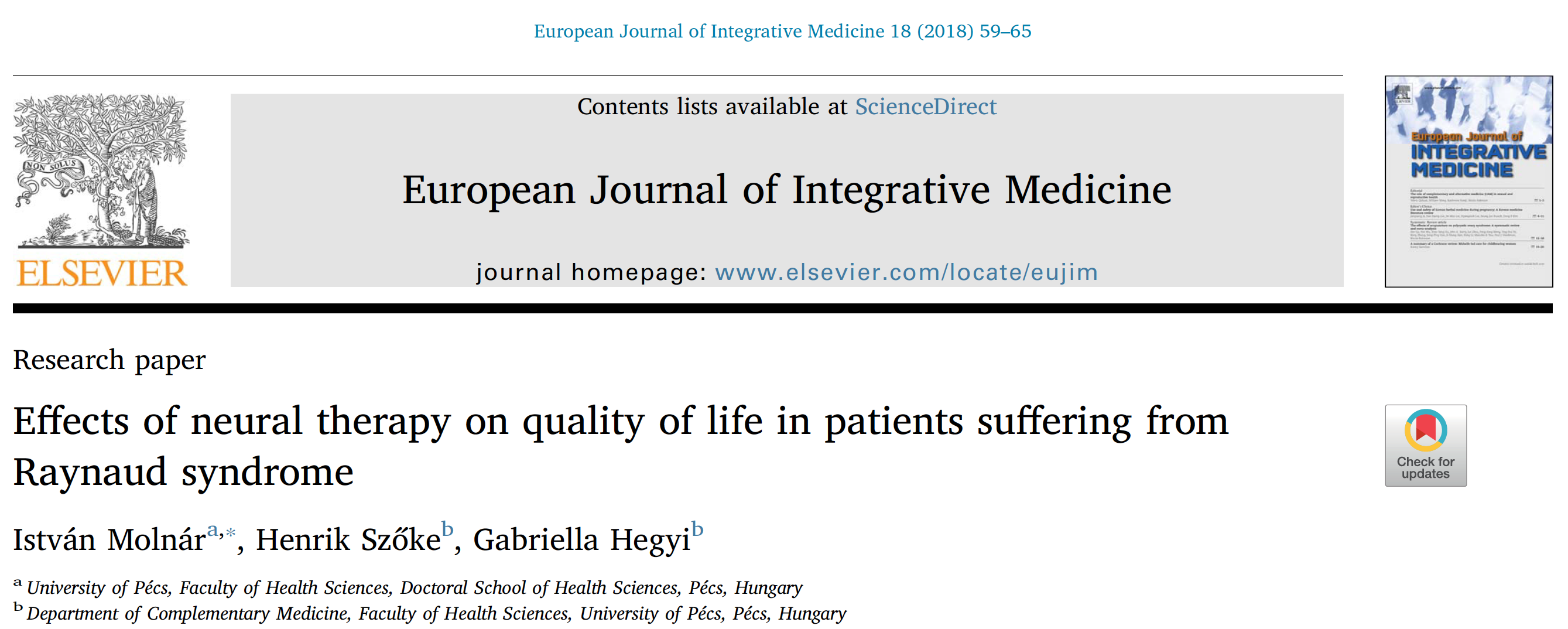
ABSTRACT
Introduction: Arterial circulatory deficiency in the upper limbs with repeated vasomotor contraction can cause serious tissue hypoperfusion functional deficiency and trophic abnormality, deformation in the distal area of the hands. This pathogenesis limits the ability to work, inhibits patients‘ self-management, and significantly reduces their quality of life (QoL). In our outpatient pain-clinic we mainly see patients suffering from primary and secondary Raynaud syndrome in all three stages after standard immunological, angiological and vascular-surgical investigations and treatments showed up to be ineffective.
Method: We applied stellate ganglion block (SGB) described first by Leriche and La Fontainea, adapted by Dosch as a special form of neural therapy (according to Hunecke) with para-tracheal technique on the effected side and conducted a prospective non-randomised case series. The treatment period took three weeks with the intervention repeated twice a week. To assess the effects of SGB on the arterial circulation of the hands, the consecutive ischaemic pain, the changes in trophic disturbances and patient’s quality of life − using validated objective and subjective measurements.
Results: From the data of 12 examined and treated patients were collected. The average follow up time was 35 days after treatment. Aggregated changes in the skin temperature of the fingers showed significant improvement (p=0.002). Out of the 3 parameters of trophic disorder of the II-IIIrd fingers the aggregated changes showed significant improvement (p < 0.05). Correlating with these objective parameters, subjective parameters as VAS values (p=0.001) and aggregated change of SF-36 questionnaire (p=0.005) showed a significant improvement. No lasting complications were detected.
Conclusion: Our study is the first to evaluate SGB as a complementary treatment in addition to conventional standard care and employ subjective and objective outcome measurements, in a group of patients with Raynaud syndrome. These promising findings are an indicator for further research.
KEY WORDS: Keywords: Vasoplastic disease, Raynaud syndrome, Ischaemic pain, Neural therapy, Stellate ganglion, Block (SGB), Quality of life (QoL), VAS, Case series
More info
Method: We applied stellate ganglion block (SGB) described first by Leriche and La Fontainea, adapted by Dosch as a special form of neural therapy (according to Hunecke) with para-tracheal technique on the effected side and conducted a prospective non-randomised case series. The treatment period took three weeks with the intervention repeated twice a week. To assess the effects of SGB on the arterial circulation of the hands, the consecutive ischaemic pain, the changes in trophic disturbances and patient’s quality of life − using validated objective and subjective measurements.
Results: From the data of 12 examined and treated patients were collected. The average follow up time was 35 days after treatment. Aggregated changes in the skin temperature of the fingers showed significant improvement (p=0.002). Out of the 3 parameters of trophic disorder of the II-IIIrd fingers the aggregated changes showed significant improvement (p < 0.05). Correlating with these objective parameters, subjective parameters as VAS values (p=0.001) and aggregated change of SF-36 questionnaire (p=0.005) showed a significant improvement. No lasting complications were detected.
Conclusion: Our study is the first to evaluate SGB as a complementary treatment in addition to conventional standard care and employ subjective and objective outcome measurements, in a group of patients with Raynaud syndrome. These promising findings are an indicator for further research.
KEY WORDS: Keywords: Vasoplastic disease, Raynaud syndrome, Ischaemic pain, Neural therapy, Stellate ganglion, Block (SGB), Quality of life (QoL), VAS, Case series
More info
